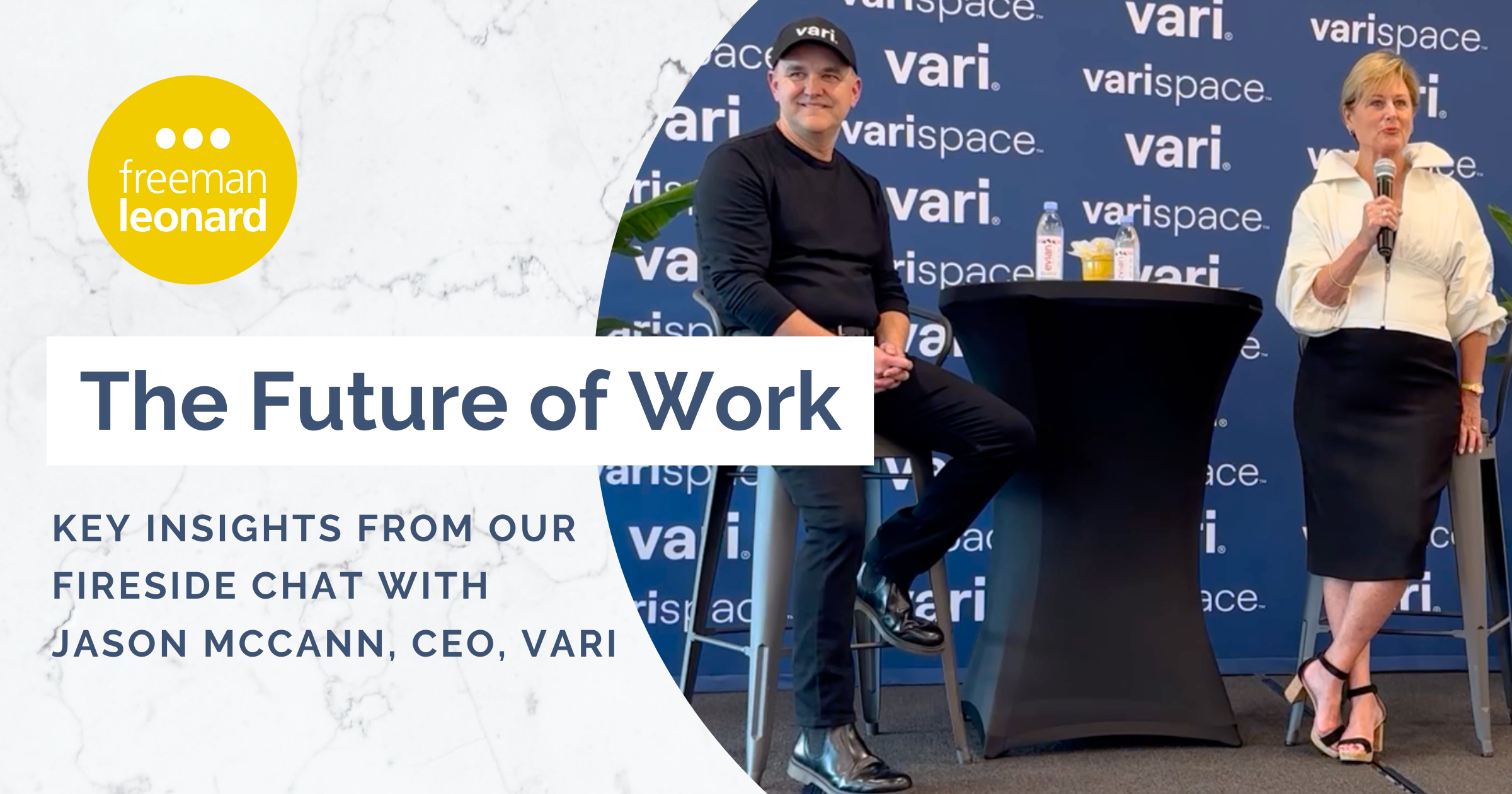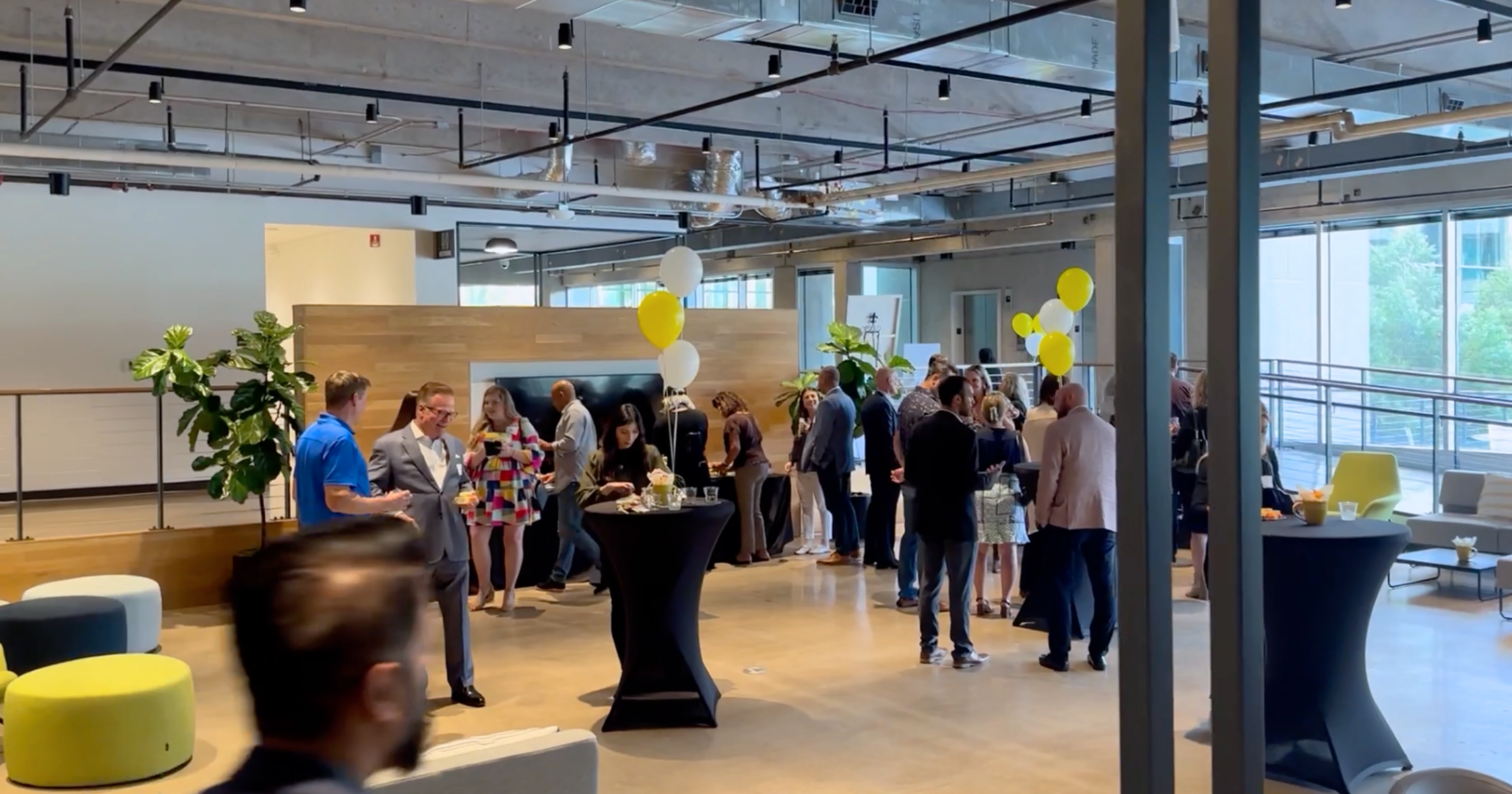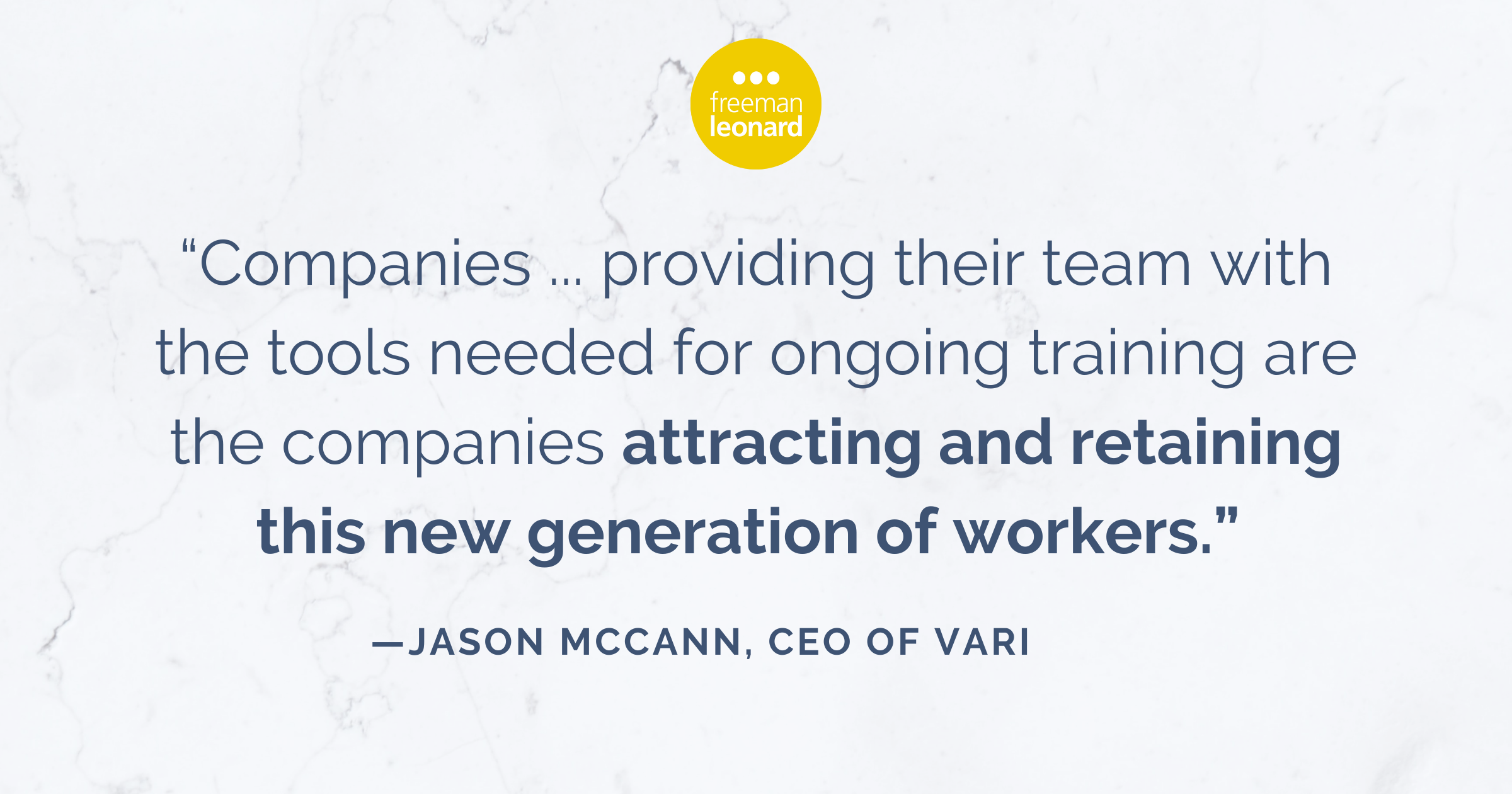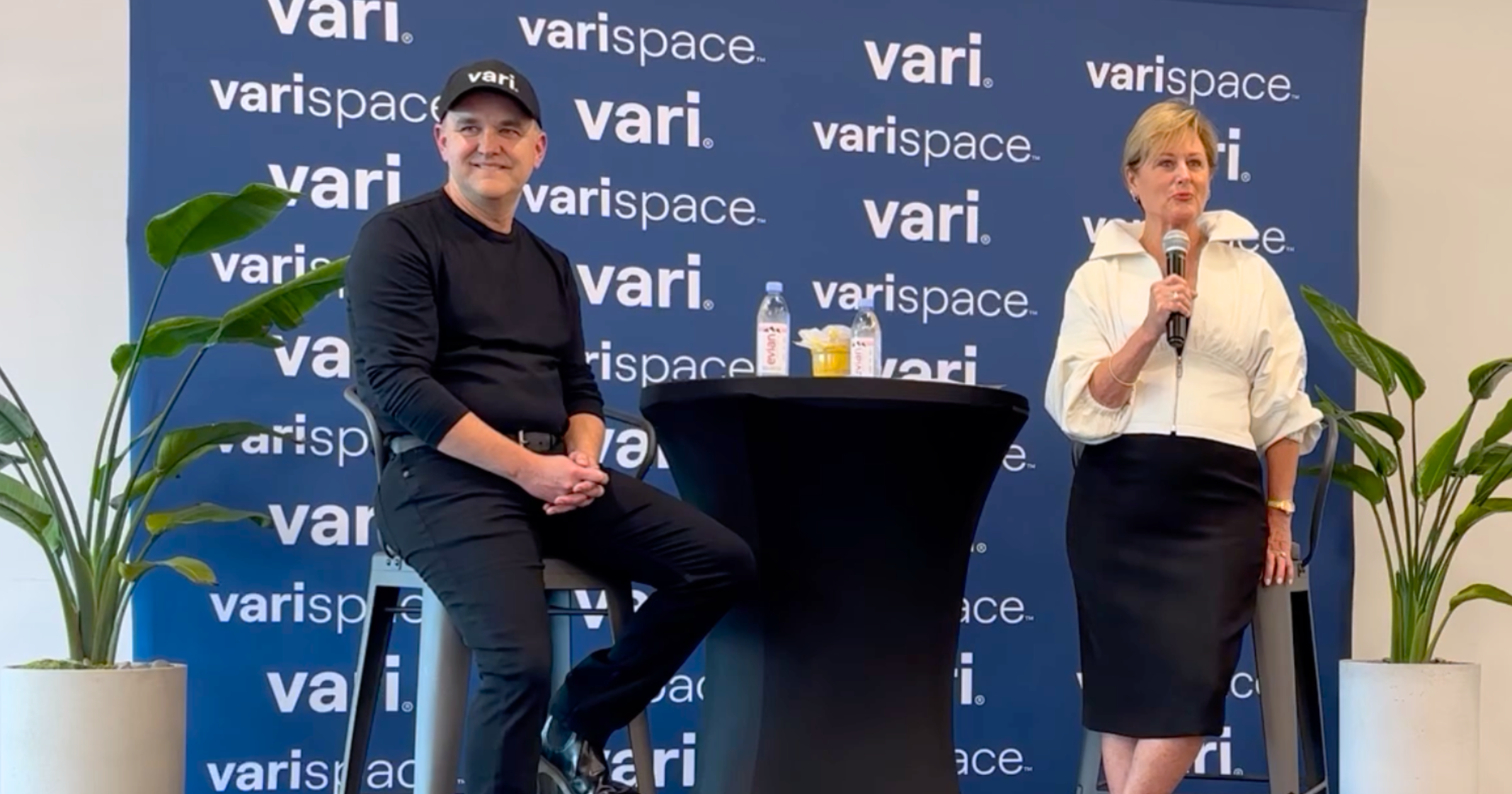The Future of Work: Key insights from our fireside chat with Jason McCann, CEO of Vari
The Future of Work: Key insights from our fireside chat with Jason McCann, CEO of Vari
 At Freeman+Leonard, we strive to stay ahead of the curve, and our recent event with Jason McCann, CEO of Vari, was no exception. Our compelling discussion, hosted by Freeman+Leonard President and CMO, Kathy Leonard, involved a variety of factors shaping the workplaces of tomorrow.
At Freeman+Leonard, we strive to stay ahead of the curve, and our recent event with Jason McCann, CEO of Vari, was no exception. Our compelling discussion, hosted by Freeman+Leonard President and CMO, Kathy Leonard, involved a variety of factors shaping the workplaces of tomorrow.
For those who missed it or need a refresher, here are our top takeaways:
1. A new focus on flexibility and health
Without question, the pandemic has reshaped our perspective regarding work. Beyond the immediate effects of the virus, businesses have also had to navigate challenges from external events such as wars and supply chain disruptions, along with other issues such as the mental health of their employees.
“A lot of things got tested and challenged… pressure was put on businesses and it turned the world upside down,” said Jason McCann. “We’ve had to fast-forward our way of thinking when it comes to business. Companies now focus on flexibility and overall health because the way that people work and interact has changed.” These new priorities are now at the forefront of the work conversation, driving an emphasis on hybrid work and expanded health benefits for workers.
 2. A shift toward more interactive workspaces
2. A shift toward more interactive workspaces
Gone are the days of traditional, static offices where everyone worked in isolated cubes. These times call for interactive spaces that facilitate solo and collaborative tasks.
“Over 50% of the commercial buildings we design today provide spaces for people to connect at the office in the same way they connect outside of the office,” said McCann.
From green spaces to coffee shops to state-of-the-art gyms, companies must understand the culture of the talent they are trying to recruit, and incorporate those values into the design of their workspaces and the DNA of their companies.
3. Embracing the remote-work revolution
While the upward trend of remote work offers greater flexibility, it also presents challenges. The emphasis now is on equipping home workspaces with the right tools and focusing on continuous learning, wellness, and community involvement as central tenets.
“Companies who have defined their core values, identified their goals, and are providing their team with the tools needed for ongoing training are the companies attracting and retaining this new generation of workers,” McCann said.
He also noted the global trend towards decentralized office models, often closer to residential areas, making going into the office a lot more convenient.
 4. Customer-centric innovation always wins
4. Customer-centric innovation always wins
Vari, which has an impressive 300-product portfolio and strong sales, has succeeded mainly because it relies heavily on customer feedback and user testing. Their approach to product development, from chairs to dynamic workspaces, has always been about addressing real-world needs. So McCann shared the office space Vari owns is most valuable not as real estate to lease, but for testing of new products.
McCann said there is great value in “listening and having a relationship with your customers.” In developing products customers actually need and want, it’s critical to consider this feedback along with actual usage patterns and user behaviors.
5. Robots: tools, not threats
The introduction of robots (physical or otherwise!) in the workplace has sparked conversation about automation and AI replacing human jobs. However, robots should be seen as tools that enhance efficiency, not as replacements for human skills and interactions.
To demonstrate, Vari partnered with RobotLabs in introducing Future of Work attendees to “Pepper.” McCann described Pepper as a tool and aid, very similar to how a car gets you to work, or how a smartphone helps you do your job. At the event, Pepper guided guests on where to go, and another robot served drinks poured by the (human) bartender.
McCann said that if business leaders can “explore the ideas that technology is bringing, it will actually provide a tremendous number of jobs and opportunities for the future workforce.”
 6. Embracing Gen Z with empathy
6. Embracing Gen Z with empathy
The youngest generation to enter the workforce, Gen Z, brings a blend of tech-savviness and self-learning prowess. Yet, the importance of face-to-face mentorship and interactions can't be overlooked for this tech-comfortable generation.
While Gen Z has grown up with access to nearly every kind of consumer technology, the pandemic has caused significant workplace isolation during their first years in the workforce. Many have yet to acquire the social and interpersonal skills needed to effectively function in the workplace.
McCann said that “leaning in to this younger generation and showing empathy and love - much like you do with your kids - can be a hard shift for leaders. But embracing Gen Z and going along with them on their journey is important.”
For these younger workers, “soft skills” that allow them to interact effectively in the workplace must be taught – and “showing” is a more effective teaching strategy than “telling.” As leaders, we must lead by example.
 7. A dawning new reality
7. A dawning new reality
With breakthroughs in virtual reality and “mixed reality”, as with Apple’s Vision Pro headset, technology is being integrated into physical spaces in new ways – and will ultimately redefine our work environments. We’re just not there quite yet.
Though the technology is still early in development, McCann predicts it will only get better and become more a part of our daily lives. And as that happens, more companies will integrate virtual and mixed-reality technologies into their workspaces. (Hopefully, the product leaders responsible for these innovations are taking careful note of insight #4 above.)
—
McCann closed the event by saying, “If I can help the next generation of entrepreneurs build the companies of their dreams, then I’ve done my job. And if the next generation beyond me takes it to a whole other level, then I’ve really done my job. And that is what excites me!”
As we navigate these transformative times, candid conversations like these are instrumental in guiding us toward a workplace that works for everyone.
Stay tuned for more insights from Freeman+Leonard as we continue to explore and define the next era of work.
Why Q4 is an ideal time to hire and onboard new employees
Why Q4 is an ideal time to hire and onboard new employees
 Don’t write off December!
Don’t write off December!
Over the years, we’ve noticed a troubling pattern: hiring tends to go on hiatus in Q4.
It’s certainly not because business has slowed. With leadership focused on hitting year-end numbers and top performers aiming to make their bonuses, there’s plenty of activity afoot. But as talent acquisition professionals, we’ve come to expect a lull in our workload each year heading into fall. And while we understand the reasons, we see it as a missed opportunity.
Placing searches on hold and pushing back start dates might seem like a good idea. After all, the holiday season is coming up, lots of people will be on vacation, and hiring managers are looking forward to some downtime. However, putting staffing off till January can waste precious time that you can’t get back.
Q4 is actually a great time to hire and welcome new employees to your team. Here’s why.
1. There’s less competition for top marketing, advertising and creative talent.
Employers may be resting on their laurels at the end of the year, but top candidates in marketing, advertising and creative fields are on the move. Holidays or not, candidates are actively looking for new opportunities this time of year. This means you have a real shot at adding to your team a few marketing rockstars that your competitors otherwise might have snapped up any other time of the year.
2. You can avoid burning out your team (and keep billing).
For many consumer brands and nonprofits (and the agencies that serve them), the holidays are actually a high-volume time of year in terms of sales and revenue. Not having a full team means you may not be operating at peak performance (or billing the hours you expected) – and during the busy season, that can cost you money. Hitting a ceiling on growth is never fun, and especially not during the time of year when the lion’s share of revenue is expected.
Not to mention this stretches your existing team far too thin during a time when everyone else they know is relaxing at home with friends and family. It’s a recipe for burnout you can easily avoid by staffing up in Q4, rather than waiting for that “ideal” moment in the new year.
3. Your new hires get to learn ‘by osmosis’ while your team strategizes for the year ahead.
The end of the year is a natural time to reflect on the progress you’ve made, reassess the challenges you’ve faced, and look forward to what you hope to accomplish in the months ahead.
This gives your new employees a unique opportunity to absorb information about the company and their role that will be vital to their success, simply by being in the room during important discussions.
Your new hires get to see the 30,000-foot view before the year begins and before they (and everyone else) get caught up in the day-to-day.
The fresh perspectives that new team members bring can also open your eyes to alternative approaches, potential obstacles you haven’t anticipated, or trends you might have missed – before your plans are set in stone.
Including new team members in these important discussions can also help you bond with new hires and help them feel valued and welcome.
4. You can hit the ground running in January.
As we all know, returning from the holidays at the first of the year can be grueling. The transition from festivities and Hallmark movie binges to a calendar chock-full of meetings and deadlines can be a shock to the system. Not the best atmosphere for onboarding a new hire.
When you fill open positions in Q4, you avoid thrusting new hires into the weeds on day one. A more laid-back schedule means they have space to review materials, and get up to speed on your systems and technology rather than jumping right into a project. And while your team is less busy, they can show them the ropes.
Most employees don’t start contributing immediately, anyway. A late-year start date gives them plenty of time to get acclimated before their output is truly needed.
5. ‘It’s the Most Wonderful Time of the Year’… to mix and mingle!
Ramping up in a new role is about more than getting the hang of the job itself. Fitting in — meeting your co-workers, learning who’s who, and familiarizing yourself with the company culture — is a big part of onboarding success.
But when your team is remote or hybrid, opportunities for face time are less abundant – except, perhaps, at the end of the year. Q4 hosts a flurry of in-person events, lunches and holiday parties. No matter what traditions your employees celebrate, or how many of them work remotely, year-end is a wonderful time to gather in-person.
All the merrymaking provides a natural opportunity to introduce new employees to the rest of the team (and clients) before everyone retreats into their home offices for the rest of the winter.
This worked well for Brittani Kroog, who kicked off her remote job as Recruiting & Talent Sourcer at Freeman+Leonard in Q4 of 2021 with an in-person day at the company’s coworking space. “It was great meeting HR, IT and my manager in person, followed by a team lunch. That was a very personable first day,” she says. “Starting in December also meant I got to have social time with everyone for the holidays, which was so nice.”
Getting bumped to January means missing out on the casual team bonding and personal connections that Q4 onboarding affords. (Plus, your Q4 new hires will get to be in on the holiday party inside jokes in January, instead of feeling even more like an outsider.)
It’s not too late to add to your team this year.
Whether you’re thinking about pausing an active search or delaying a new search for the next couple of months, we encourage you to think again.
We see it every year — employers who continue to recruit in November and December have an edge over those who don’t.
The marketing and advertising talent experts at Freeman+Leonard can help you with your search and onboarding process year-round. The hiring landscape is still competitive, but strong candidates enter the job market daily. Strike while the iron is hot, and don’t miss your chance to tap the advantages of Q4 onboarding.
Use the contact form below to reach out and start a conversation. It costs nothing to explore your options.
Get in touch with a Freeman+Leonard consultant today:

